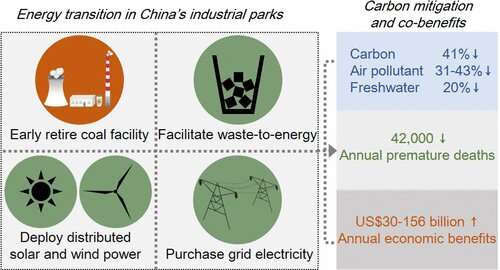Credit: Environmental Science & Technology (2023). DOI: 10.1021/acs.est.2c05725
The industrial sector—made up of businesses that support processing raw materials for manufacturing and consumer goods—is a major contributor to greenhouse gas emissions and one that has proven difficult to decarbonize. In China, much of the industrial sector is organized into "parks" that have been zoned as areas for concentrated industrial activities. China has more than 2,500 industrial parks that are currently largely powered by coal. A recent study led by researchers at Princeton University finds that this clustering of industry provides unique and overlooked opportunities for targeted energy supply emissions reduction efforts.
The article published in the journal Environmental Science and Technology analyzes how specific decarbonization solutions available to Chinese industrial parks can bring China and the world closer to net-zero goals while achieving additional benefits in the form of freshwater savings and health benefits.
"Industrial parks can be a pioneer for low-carbon policies in practice," said Yang Guo, the lead author and an associate research scholar at the Center for Policy Research on Energy and the Environment at Princeton's School of Public and International Affairs.
The team of five Princeton engineers and policy experts, along with colleagues from several Chinese universities and industry, studied 850 industrial parks and found that by using a mix of electricity from the grid and onsite green power, these hubs could meet their energy needs and cut greenhouse gas emissions by 40%.
The researchers based their decarbonization scenario for industrial park energy supply on existing energy policies in China, which include phasing out coal, increasing the use of onsite solar and wind energy, as well as increasing the use of energy recovered from waste incineration. To make up for any energy supply gaps, their decarbonization scenario also includes additional electricity from grid and heat from onsite natural gas plants.
Next, to quantify the benefits of their proposed decarbonization pathway, the authors estimated the carbon and air pollutant emissions as well as freshwater consumption of each of the 850 industrial parks. A regional air quality model was used to calculate air pollution levels arising from 2030 baseline and mitigation scenarios for industrial park emissions. The researchers, keeping emissions from all economic activities constant except industrial parks, then quantified the carbon, water, health, and economic benefits of their proposed 2030 industrial park mitigation pathway versus a baseline 2030 industrial park pathway that retires fossil fuel facilities according to a normal schedule (such as a 30-year lifetime for coal-fired facilities).
The researchers found that their proposed mitigation pathway reduces greenhouse gas emissions by about 40% overall, after accounting for onsite emission reductions which are partially offset by emission increases from increased grid electricity and natural gas usage. This is equivalent to 7% of China's total emissions in 2014. Freshwater consumption also decreases by about 20%, with the biggest reduction in water stress seen in the most water-scarce provinces. In addition to these benefits, the associated net reduction in air pollution exposure leads to about 42,000 avoided premature deaths in 2030. Finally, the authors calculated that the net economic benefits arising from decarbonizing the industrial parks and from avoided premature deaths far outweigh the costs of changes in equipment and energy usage, eventually bringing between US$30-156 billion of net economic benefit to China in 2030.
"A clean energy transition in industrial hubs can provide large environmental, health and economic benefits," said Denise Mauzerall, a corresponding author of the study and faculty at the Center for Policy Research on Energy and the Environment at Princeton University.
Decreasing the reliance of China's industrial sector on fossil fuels would help speed up China's green transition and avoid fossil fuel infrastructure lock-in. The authors conclude that the large net benefits estimated by this study can help justify the investments and policy interventions needed to move China's industrial parks towards a cleaner energy pathway.
Given the world's dependence on exports from the Chinese industrial sector, any efforts to decarbonize it will have far-reaching, global benefits for international supply chain emissions.
Study authors include Yang Guo, Mi Zhou, Liqun Peng, Mingwei Li, and Denise Mauzerall (Princeton University), Juhua Yang (China Huadian Corporation Ltd), Jinping Tian and Lyujun Chen (Tsinghua University).
More information: Yang Guo et al, Carbon Mitigation and Environmental Co-Benefits of a Clean Energy Transition in China's Industrial Parks, Environmental Science & Technology (2023). DOI: 10.1021/acs.est.2c05725
Journal information: Environmental Science & Technology , Environmental Science and Technology
Provided by Princeton University
























